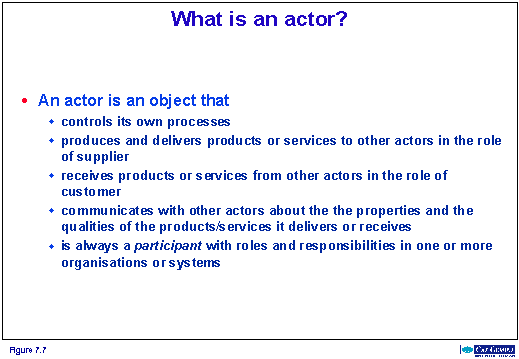Outline of ProgrammeX
| 7. Architecture |
7.2 What is Architecture?Information and Communication Technology (ICT) will provide us with the capability to renew and even reinvent the business. Chapter 3 provided a global picture of the ICT enabled Web Enterprises and the ICT systems of the 21st Century.
New approaches are needed for designing and realising these complex virtual enterprises and ICT systems. This approach must consider the business and the supporting ICT system as one whole in order to guarantee that:
- The alignment between business and ICT is optimal;
- ICT really enables the business;
- The components of both the business and the ICT system collaborate and communicate well together;
- The transformation of the business and the ICT system are feasible;
- The ICT system is durable;
- Both the business and the ICT system are flexible and adaptable in those aspects and to that extent that the business needs;
- The ICT systems of different companies and private individuals can communicate and co-operate with each other;
- The quality profile of the ICT systems matches the quality profile of the business.
Cap Gemini believes that the only way to realise these goals is to use an integrated architectural approach to the design of both the business and ICT system.
Cap Gemini sees architecture as the key for the development of ICT enabled business.
7.1 An Example of Integrated Architecture: A Virtual Bank
A Virtual Bank is a good example why an integrated architecture is needed for the design and realisation of both business and the ICT system of a company. This example is based on an existing virtual bank the Open Bank, a subsidiary of the Spanish Grupo Santander. Cap Gemini developed the ICT system of Open Bank.This virtual bank is a first step in the direction of the agile Web Enterprise.
In this example we show how the Cap Gemini Architecture support an integrated design of business and ICT. The Cap Gemini Architecture integrates the architectural design of the aspects business, information, information system and technology infrastructure.
7.1.1 Business and Information
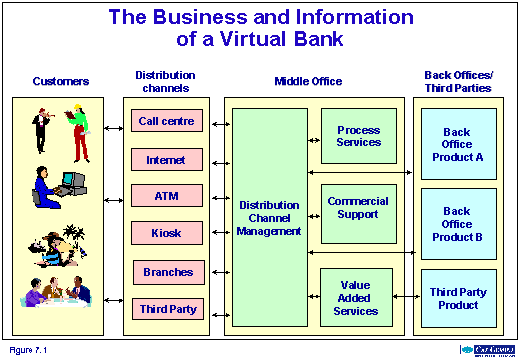
The virtual bank uses a call centre and the Internet as main distribution channels to the clients. The bank also uses distribution channels like automatic teller machines (ATM), electronic kiosks, branch offices and third parties. The bank delivers different financial products to their clients and also offers value-added services based on products of third parties.
The result is a complex organisation consisting of organisational units that are responsible for certain business roles. Together these organisational units are able to form different supply chains that deliver products and services to the customers.
The organisational units and their roles are:
- Different distribution channels responsible for the delivery of the services to the customer.
- Back-offices of the bank, responsible for the administration of the products of the bank. A back-office executes the financial and administrative transactions for a certain type of product;
- Third parties responsible for the administration of their specific products.
- A middle-office responsible for roles that support and co-ordinate the whole supply chain.
Examples of the roles of the middle-office are:
- Distribution Channel Management
This is the co-ordination and control of the communication between the distribution channels, the middle-office and the back-offices/third parties. This includes authorisation of customers for the use of distribution channels and for the access to services and products in the middle-office, back-offices or at third parties.- Process Services
These services support customers or employees in performing more complex processes. Examples are:
- A customer asking an overview of all his accounts.
- A team of employees making a new contract offering to a customer.
- Commercial Support
These services support for instance
- The marketing of products.
- Gathering of information about the customers, products and services.
- The development of new or improved products, services or distribution channels.
In the architectural design of the business the Cap Gemini Architecture supports a coherent business design consisting of:
- The organisational units like distribution channels, middle-office and back-offices.
- The roles of the organisational units, inclusive the business processes corresponding to these roles.
- The "construction" of financial products and services.
- The communication and co-operation between the different organisational units and business roles in the supply chain.
Special attention is paid to the design of the role of information in the business. This results in an information design, which is part of the business design. The information design is not shown here.
The information design consists of:
- The information and knowledge supporting the organisational units, business roles and business processes in the business.
- The communication between the different organisational units and roles
- The information and information processes needed for the control and co-ordination of the business processes. This is especially aimed at the roles "process service" and "distribution channel management" in the middle-office that control and co-ordinate processes in the whole supply chain.
7.1.2 Information System

The Cap Gemini Architecture supports a design of the (automated) information system of the virtual bank that is aligned with business design in order to give maximum enabling of the business
The information system is divided into subsystems that correspond to the different organisational units and their business role. Every business role has its own information (sub)system, which consists of the applications and data that support the specific business processes and business information of that role.
The bank uses more types of distribution channels including ATM, Internet, kiosk and branch office. Every type of distribution channel has its own information system with specific applications and data.
The information system of the Internet channel for instance consists of an Internet browser at the PC of the customers and a Web-server at a communication server of the bank. The customer uses the browser to communicate via the Internet with the Web-server, which has specific applications that communicate with the customer through Web pages. The Web-server also communicates with the Distribution Channel Management Information System that gives the customer access to other information systems within the bank.
The organisation has multiple back-offices. Each back-office has its own information system supporting the business information and business processes for a specific type of product.
The middle-office has its own information systems, for instance:
- Distribution Channel Management, which supports and controls the communication of information systems in the distribution channels with information systems in middle-office, in back-offices or of third parties.
- Process Services, which provide a flexible control of the pattern of execution of business processes within a transaction. An example is the control of process handling a request of the customer of an overview of his accounts or the workflow management of administrative processes.
- Commercial Support, for instance a data warehouse application for storage and analysis of marketing, customer and product information.
The Cap Gemini Architecture supports the design of this type of distributed information systems. The architecture support a coherent information system design consisting of:
- the specific information subsystems of the different organisational units that support their specific business roles, processes and information;
- the design of the communication interfaces between these information systems;
- the design of the human/computer interfaces for the customer and the employees.
The information system design also supports the required dynamic properties of the business:
- easy addition of new channels, new products in back-offices, new third parties and new supportive roles in the middle office;
- easy access for the customers to their products via different channels;
- a uniform interface for the customers to all their products.
7.1.3 Technology Infrastructure
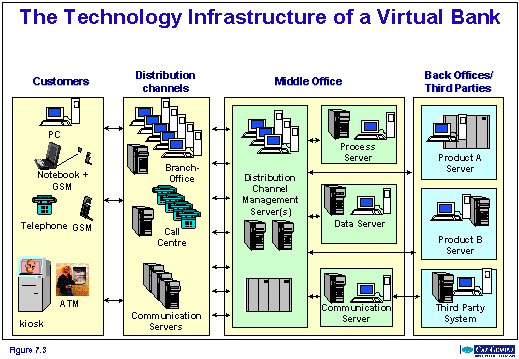
The technology infrastructure is divided into subsystems that support the different information subsystems from the information system design. Generally, every subsystem has its own computers. The computers of the different subsystems are interconnected via networks (the Internet or private networks).
Every distribution channel may have specific technology. The ATM channel for instance consists of a number of ATMs at different locations, which communicate through a network and one or more communications servers with the computers of the middle-office.
The technology of the back-office systems may be a mainframe or a cluster of computers.
The technology infrastructure of the middle-office consists of different computers in the role of communication server for the distribution channel management, process server for the process services or data server for the commercial support.
The servers in the middle-office play also a crucial role in linking together the different hardware/software technologies in the distribution channels and in the back-offices.
The Cap Gemini Architecture supports the design of this type of networked technology infrastructure with optimal capabilities for the support of different information systems. Based on the type of information systems, the required capability, capacity and other qualities, appropriate products are chosen based on a coherent set of ICT standards.
7.1.4 Conclusion
The Cap Gemini Architecture supports a coherent design of the business, information systems and technology infrastructure of a virtual bank. The design divides the bank in organisational units with specific roles in the business process of the bank. Information systems and technology infrastructure are organised to support the organisational units and their business roles in an adaptive way. The bank can easily extend the business with new types of distribution channels, with new products in the back-office, with new third parties or with new co-ordinating or information services in the middle-office. Changes in the organisation of the business or changes in the contracts with the customer are immediately translated in new patterns for control of the business processes by the middle-office. The result is an extremely flexible and adaptive ICT enabled business.
7.2.1 The Definition of Architecture
In the IT world the word architecture has multiple meanings. Here are the two definitions used in this context:
- Architecture is the structure of a specific IT system
Examples are technology architecture for the technology infrastructure or software architecture for the software. This architecture is the result of the design process. The architecture prescribes:
- the type of components of which the business or ICT system may be composed;
- what type of role(s) these components can play in the system;
- how the components communicate and co-operate together in delivering services to actors outside the system;
- how the behaviour and collaboration of these components is managed and controlled
- Architecture is a reference architecture
Architecture is a set of principles, rules and guidelines that support the design of a system. This definition means that systems with different functionality are designed with use of the same reference architecture. The architecture as reference architecture results in systems with common characteristics. An important result for instance is that systems of different companies can communicate and co-operate together because the architecture prescribes compatible standards for communication.Cap Gemini uses the following definition for its architecture:
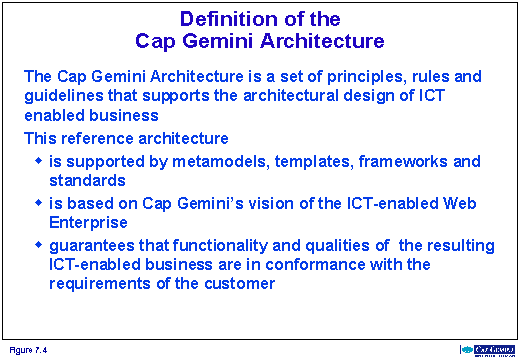
The Cap Gemini Architecture is a set of principles expressed in rules and guidelines that acts as reference architecture (meaning 2) for the design of the architecture of business and ICT systems (meaning 1). Cap Gemini is developing this reference architecture. We support the architecture with metamodels, templates, frameworks and industry standards for the design and construction of business and ICT systems. Cap Gemini uses the same architecture as reference for the design of the specific business and ICT system of different customers. All these systems will have a specific functionality based on the type of business of the customer. But because these businesses and ICT systems are designed with the same reference architecture, they all show the specific characteristics of the Cap Gemini architecture in their style, engineering and construction.
This is the same with buildings that are designed by the same architect or school of architects. All these buildings can have different roles (such as church, house or office) and have their own specific architecture. But all these buildings show common characteristics in style, engineering and construction that are typical for the architect, who designed them.
7.2.2 The Role of Architecture
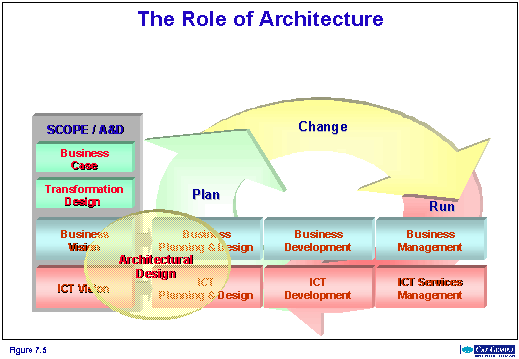
The principles, guidelines and rules stated by the Cap Gemini architecture support primarily the architectural design of the business and ICT system. The architectural design starts during the SCOPE or Analysis and Design with a global design or a "city plan" of the new or renewed business and ICT system in support of the business and ICT vision. The global architectural design supports the decision making about the business and ICT transformation. The planing and design of the different projects within the transformation programme starts with a more detailed design of the part of the business and ICT system that is delivered by the project. This detailed design supports the decision-making of the customer about the exact realisation of the change.
The architect prepares a global or detailed architectural design that provides a clear picture of the functionality, the structure, costs and qualities of the resulting business and ICT system. The customer reviews the design for usability and functionality and business and ICT experts assess the feasibility of the design and also the risks and costs of realisation. This may cause changes in the design. The customer accepts the final design, which meets the expectations regarding functionality, qualities and costs and starts the business and ICT transformation or he rejects the design and cancels the transformation or project.
The Cap Gemini architecture supports the design of business or an ICT system through principles, guidelines and rules for:
- the type of components of which the business or ICT system may be composed;
- what type of role(s) these components can play in the business of ICT system;
- how the components communicate and co-operate together in delivering products or services;
- how the behaviour and collaboration of these components is managed and controlled
The architecture serves as a reference for the design of the business and ICT system. The reference architecture guides the architect towards a design that complies with the vision and concepts of the architecture. The architectural design also impacts the development of the new of renewed business and ICT system and the management or better manageability of the resulting business and ICT system. The developers change the business and realise the ICT system in conformance to the architectural design. The style, functionality and qualities of the resulting business and ICT system will inherit the added value of the architecture. The business and ICT will be recognised as being 'designed under Cap Gemini architecture'.
7.3 The Integrated Architecture Framework
The Cap Gemini Architecture pertains to both business and ICT systems and comprises various aspects and abstraction levels. The Cap Gemini Architecture consists of a number of areas that are positioned and interrelated in the Integrated Architecture Framework (IAF).
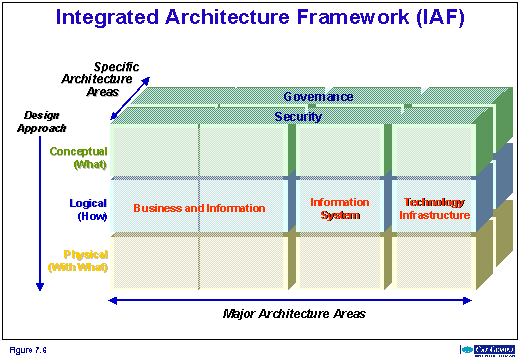
IAF has three dimensions. The first dimension contains the major architecture areas. These major architecture areas are sub-architectures within the Cap Gemini architecture. These areas are:
- The business architecture supporting the design of the business. The architecture covers the following aspects of the business: commercial, organisation, processes, personnel, administration and finance. Information-oriented aspects of the business are not included.
- The information architecture supporting the design of the information-oriented aspects of the business. The architecture covers the following aspects: information, knowledge, communication and co-ordination/control. The information architecture is in fact a subset of the business architecture. We identify it as separate area in order to make an explicit information architecture that acts as a bridge between business architecture and the information system architecture. The information architecture supports the realisation of a specific information design for a company. The company decides which part of this information design is realised as automated information system.
- The information system architecture supports the design of the applications (software and data) of the (automated) information system. The information system is normally a network of information (sub)systems, knowledge systems, communication systems and/or control systems. The information system is the automated part of the information design. The information system is specifically designed to support the business of a company. Information system architecture differs from software architecture. Information system architecture focuses on the role of applications in the business processes. The information system architecture is function-oriented
In our opinion software architecture is a subset of the information system architecture. The software architecture focuses on the construction of applications from software components. The software architecture is construction-oriented.- The technology architecture supports the design of the technology infrastructure that supports the information system. This architecture is aimed at the design of a technology infrastructure with the right capabilities (qualities and capacity) to support the information system. The technology architecture also regards the design of the physical distribution of software and hardware.
The second dimension contains the specific architecture areas. These are sub-architectures, which prescribe the design of organisational aspects, which are the consequence of the introduction of an ICT system. These sub-architectures give prescriptions in all the four major areas. Currently Cap Gemini has recognised two of these specific architectures:
- The governance architecture structuring the governance or ICT services management and the consequences for the design and construction in all four major architecture areas. The introduction of an ICT system makes it necessary to implement an ICT services management organisation. The governance architecture prescribes the design of the "business", information, information system and technology infrastructure of this ICT services management organisation.
- The security architecture structuring the security services and the consequences in all four major architecture areas. The result is the design of all aspects of a security organisation.
Both security and governance are realised by certain business procedures for the company and a supporting organisation (department and/or third parties). The governance and security processes are supported by dedicated information systems and technology infrastructure.
The third dimension is the design approach. The design of the major and specific areas follows three cycles with each its own resulting design models. These cycles are:
- The conceptual cycle that answers the question: what will be realised? For instance: what new business will be realised?
- The logical cycle answers the question: how will it be realised? For instance: How will this new business be realised? How will this new business function be structured?
- The physical cycle answers the question: with what will the new business be realised? For instance: which resources (i.e. employees, applications, ICT, buildings) are needed for this new business?
7.4 Actor-based Architectural Design
ProgrammeX will develop the Actor-based Architectural Design Approach as a new content for the Integrated Architecture Framework. This approach is especially aimed at the design of the business processes and ICT systems of the ICT enabled Web Enterprise.Actors are self-controlling objects. In the design of business and ICT system we discern the following actors:
- human beings in the business,
- self-controlling applications in the information system,
- self-controlling software components and hardware components in the technology infrastructure.
The actor-based architectural design sees the Web Enterprise as an organisation of human beings, applications, software and hardware collaborating together as self-controlling actors in the production and delivery of products and services to the customer.
7.4.1 What is an Actor?
Here follows the definition of an actor.7.4.2 Actors in the Web Enterprise
In our view on the Web Enterprise are three types of actors: human actors, information system actors (IS actors) and technology infrastructure actors (TI actors).
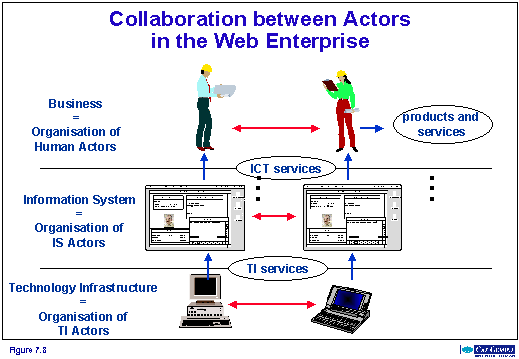
The above picture gives an impression of the collaboration of these actors in business, information system and technology infrastructure.
The business of a company is seen as a network of communicating and co-operating human actors. Human actors are:
- individual people in roles such as manager, employee or customer;
- organisational units such as teams, departments or companies, which act as one actor in the delivery of a product or service to another human actor.
The business is organised as one or more supply chains or a flexible supply web of human actors like individuals, organisational units and companies working together in delivering products or services to the customers.
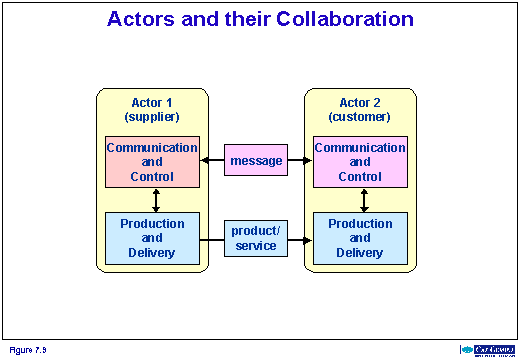
The above picture shows how two human actors collaborate in the supply chain. Actor 1 as supplier delivers a product to actor 2 as customer.
The external behaviour of the actors consists of:
- the exchange of messages in a conversation about the production and delivery of the product,
- and the delivery of the product from actor 1 to actor 2.
The internal processes of the actors are separated in two main functions:
- The Communication and Control (C&C) function, which exchanges messages with other actors about the production and delivery of products and services and controls the production and delivery processes of the actor.
- The Production and Delivery (P&D) function, which accepts products or services from other actors and produces and delivers products and services to other actors.
The collaboration between the actors will start with a message from actor 2 to actor 1 with the question: can you deliver a product to me? The actors have a conversation about the exact properties and qualities of the requested product. When they agree, actor 2 will give an order to actor 1 to deliver the product. The whole conversation is between the C&C functions of the actors.
The C&C function of Actor 1 now starts its P&D function for the production and delivery of the product to actor 1. The C&C function of actor 1 controls the execution of the whole production and delivery process.
The C&C function of actor 2 starts its P&D function to receive the product and checks if it is in conformance with the order. When this is the case actor 2 sends a message to actor 1 that the product is accepted. The collaboration is successfully ended.
This collaboration of two actors forms the basis for the organisation of supply chains where human actors work together in the production and delivery of complex products and services. The actors in the supply chain have different roles such as:
- a production role: the production and delivery of a product component
- a supportive role: helpdesk for information systems
- a management or co-ordination role: business unit manager
A Web Enterprise takes maximum advantage of the self-control of human actors and their communication about the production and delivery of products.
Human actors use communication and self-control to adapt their pattern of collaboration in the production and delivery processes. They adapt both the supply chain and the composition of the resulting product or services to the wishes of the customer. Such a communicating network organisation of self-controlling actors behaves as an organism that adapts to its environment.
7.4.3 Actors in the ICT System
The human actors in the Web Enterprise are supported by services delivered by the information system within the ICT system.The information system is an organisation of information system (IS) actors that delivers information services to the human actors (both individuals and organisations).
Technically IS actors are applications in the form of self-controlling subsystems. The subsystem consists of software components for:
- the communication with other actors (human actors and other IS actors);
- the control of the behaviour of the actor.
- the production and delivery of specific IS services of the actor;
IS actors are an extended form of software agents or active objects. See description in Vision chapter 3.3 and chapter 4.5.
Logically IS actors show the same behaviour in collaboration as human actors. IS actors can collaborate with each other and with human actors.
The collaboration of IS actors support the human actors in the following parts of their behaviour:
- The communication between human actors and the communication of human actors with IS actors and self-controlling machines.
- The control processes of the collaboration and operation of human actors, IS actors and self-controlling machines.
- The storage and retrieval of information and knowledge.
- The production & delivery processes of information and knowledge products and services.
In this view the IS actors are an extension of the human actors. IS actors are virtual actors that collaborate as human surrogates with the human actors. Human actors and IS actors form together an organisation.
The effect of the collaboration between human actors and IS actors on the business is more than the support of existing business processes. The collaboration also enables the human actors to develop new processes, products and services or new forms of organisation: IS actors enable new business. The ICT enabled Web Enterprise is a collaboration of human actors and IS actors.
The human actors use the self-control of the IS actors to give them orders to change their behaviour and patterns of collaboration. Within certain boundaries it is possible that the IS actors "learn" and adapt their behaviour in response to changes in their environment. The result is an information system that shows the same adaptive an agile network organisation as the human actors in the Web Enterprise.
The IS actors never take over the full responsibility for delivered IS services from human actors. There is always a human actor in the ICT organisation of the Web Enterprise who is responsible and accountable for the behaviour of the IS actors and their effect on the business.
The IS actors in the information system are supported by the technology infrastructure. The technology infrastructure is a collaboration of Technology Infrastructure actors (TI actors). There are two types of TI actors:
- Hardware devices like computers, networks, printers and disk units that have a control system. A hardware device and its control system form together a hardware actor. The control system (in fact a software agent) is responsible for the communication and control processes of the hardware actor. The hardware device itself performs the physical production and delivery processes of the services of the device. The control system makes the difference between a self-controlling hardware actor and a dumb device.
- Self-controlling System Utilities that deliver general utility services to the IS actors. Examples of this System Utility actors are a DBMS that supports the data storage and retrieval of the IS actors, a Message Queue Service that supports the communication between IS actors and a Transaction Monitor, which support the control of an IS actor.
The resulting technology infrastructure is physical a network of hardware actors like computers, networks and other devices and of the necessary system utility actors. The result is an organisation of TI actors. The IS actors of the information system are implemented on this technology infrastructure. The TI actors in the technology infrastructure deliver the following services to the IS actors of the information system:
- the physical execution of the communication between IS actors and through interfaces with human actors,
- the physical execution of the processes of the IS actors,
- the physical storage of the data and instructions (programs or classes) of IS actors.
7.4.4 Actors in the Integrated Architecture Framework

The view on actors in business and ICT system has consequences for the architectural design of business and ICT system. The architect designs the business and the ICT system as a collaboration of human actors, IS actors and TI actors.
For the Integrated Architecture Framework (IAF) this means the following design results:
- The design result of the business and information aspect is a collaboration of human actors, which delivers products and services to the customers.
- The design result of the information system aspect is a collaboration of IS actors delivering information system services to the human actors in the business
- The design result of the technology infrastructure aspect is a collaboration of TI actors delivering hardware and system utility services to the IS actors in the information system.
In the logical design cycle the architect focuses on the roles and responsibilities of these actors.
The role of an actor in the organisation is the delivery of a certain product or service. The responsibilities of an actor concern for instance the control of the quality aspects of a product or the requirement to collaborate with other actors.
The architect also designs the collaboration of the actors in the organisation that is how they can form supply chains for the delivery of a product or service and how they communicate with each other for the management an control of their collaboration.
In the physical design the architect will focus on the on the physical resources that must realise the roles of the actors.
For human actors this means a description of the competencies and skills of the person that must play the actor role.
The IS actors are physically designed as a software subsystem consisting of tailor-made and/or of-the-shelf software components.
The TI actors are also designed as a software or hardware subsystem consisting of software and hardware components.
7.4.5 Actor-based Design uses Available Technology and Existing Systems
In the actor-based approach the logical design of human actors, IS actors and TI actors describes an ideal solution that must be realised with available human and technology resources. In the physical design special attention must be paid how IS actors and TI actors are realised with available software and hardware resources like packages, development tools, middleware, operating systems and hardware. One way of realising this is the development of reference architectures with templates and patterns for the realisation of physical IS and TI actors based on available technology.Existing systems are also included in the actor-based design. The general approach is to redesign the systems to one ore more IS actors that play a role in the new ICT enabled business. Normally it is necessary to add some new functionality to the existing systems to realise them as a new group of IS actors. The whole approach is in fact encapsulation of the existing system into one or more IS actors.
7.4.6 Architectural Design of Web Enterprise Management
In the architectural design special attention is paid to Web Enterprise Management.The business management within the Web Enterprise Management is designed through:
- Roles and responsibilities of human actors and organisational units in the business.
- Communication and control functionality of human actors aimed at the management and operational control of the agile and adaptive human collaboration.
- Special governance and management roles/responsibilities of human actors
- Roles/responsibilities concerning the information exchange and knowledge creation in the enterprise.
The ICT enablement of the business management is designed through:
- Roles and responsibilities of IS actors in the ICT system that support the human actors in the business.
- Communication and control functionality of IS actors aimed at the support and reinforcement of governance, management and operational control roles of the human actors.
- IS actors supporting the information exchange and knowledge creation in the enterprise.
The ICT management within the Web Enterprise Management is designed through:
- Roles and responsibilities of human actors and organisational units within the ICT organisation.
- Communication and control functionality of these human actors aimed at the management and operational control of the ICT system.
- Special governance and management roles/responsibilities of human actors in the ICT organisation (services manager, auditor)
The ICT enablement of the ICT management is designed through:
- Roles and responsibilities of special IS actors in the ICT system that support the human actors in the ICT organisation.
- The IS actors supporting the business and the TI actors are extended with functionality for functions like maintenance, deployment, remote monitoring and control by the human actors in the ICT organisation.
The result of the actor-based design approach is a full ICT enablement of the business management and ICT management within the Web Enterprise.
The Actor-based Architectural Design and the Integrated Architecture Framework (IAF) support a coherent design for the business, the information system and the technology infrastructure of a ICT enabled Web Enterprise.The Cap Gemini Architecture supports the delivery of an architectural design of
- Companies, organisational units and employees with clearly defined roles as human actors within the business of the Web Enterprise.
- Applications in the form of IS-actors with clearly defined roles in the delivery of IS-services to the business
- A technology infrastructure with clearly defined roles in the delivery of infrastructure services and capabilities to the IS actors.
- The collaboration of all these actors in delivering products and services to the customers of the Web Enterprise.
Such an integrated architectural approach to the design of both the business and ICT system is needed because ICT provides us with the capability to renew and even reinvent the business. ICT gives us the opportunity to realise an organisation like a virtual bank and in future even more complex virtual enterprises. The integrated architectural approach considers the business and the supporting IT system as one ecosystem of collaborating actors.
The effect of the Cap Gemini architecture is an intelligent structure of both the business and the ICT system. The structure, dynamics, qualities and capacities of the business and the supporting information system and technology infrastructure are designed to have maximum flexibility and adaptability with respect to changes in both the business and the technology.
